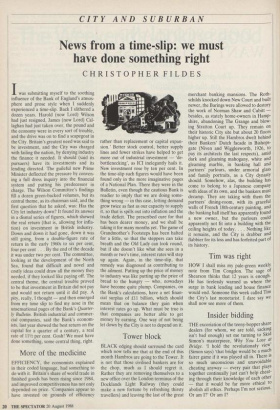Tower block
BLACK edging should surround the card which now tells me that at the end of this month Hambros are going to the Tower. It is not that those civilised bankers are for the chop, much as I should regret it. Rather they are removing themselves to a new office over the London terminus of the Docklands Light Railway (they could make a new fortune by refreshing thirsty travellers) and leaving the last of the great merchant banking mansions. The Roth- schilds knocked down New Court and built newer, the Barings were allowed to destory the work of Norman Shaw and Cubitt besides, as stately home-owners in Hamp- shire, abandoning The Grange and blow- ing Stratton Court up. They remain on their historic City site but about 20 floors higher up. Still the Hambros dwelt behind their Bankers' Dutch facade in Bishops- gate (Niven and Wigglesworth, 1926, to pay its architects the last respects), amid dark and gleaming mahogany, white and gleaming marble, in banking hall and partners' parlours, under armorial glass and family portraits, as a City dynasty should. Somehow, alas, the building has come to belong to a Japanese company with ideas of its own, and the bankers must decamp. They are taking with them the partners' dining-room, with its graceful walls of French 18th-century painting, and the banking hall itself has apparently found a new owner, but the parlours could apparently not fit into a building with the ceiling heights of today. . . . Nothing like it remains, and the City is drabber and flabbier for its loss and has forfeited part of its history.






















































 Previous page
Previous page